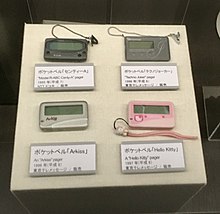
Back بيجر Arabic Пэйджар Byelorussian পেজার Bengali/Bangla Cercapersones Catalan Pager Czech Funkmeldeempfänger German Βομβητής Greek Televokilo Esperanto Mensáfono Spanish پیجر Persian


A pager, also known as a beeper or bleeper,[1] is a wireless telecommunications device that receives and displays alphanumeric or voice messages. One-way pagers can only receive messages, while response pagers and two-way pagers can also acknowledge, reply to, and originate messages using an internal transmitter.[2] In Japanese, it was commonly called a pocket bell (ポケットベル, poketto beru) or pokeberu (ポケベル),[3] which is an example of wasei-eigo.
Pagers operate as part of a paging system which includes one or more fixed transmitters (or in the case of response pagers and two-way pagers, one or more base stations), as well as a number of pagers carried by mobile users. These systems can range from a restaurant system with a single low power transmitter, to a nationwide system with thousands of high-power base stations.
Pagers were developed in the 1950s and 1960s,[4] and became widely used by the 1980s through the late 1990s and early 2000s. In the 21st century, the widespread availability of cellphones and smartphones with text messaging capability has greatly diminished the pager industry. Nevertheless, pagers continue to be used by some emergency services and public safety personnel, because modern pager systems' coverage overlap, combined with use of satellite communications, can make paging systems more reliable than terrestrial based cellular networks in some cases, including during natural and human-made disasters.[5] This resilience has led public safety agencies to adopt pagers over cellular and other commercial services for critical messaging.[6][7]
- ^ "BLEEPER | meaning in the Cambridge English Dictionary". Dictionary.cambridge.org. 25 May 2022. Retrieved 31 May 2022.
- ^ "What is pager? – Definition". WhatIs.com.
- ^ "Japan's last pagers beep for the final time". BBC News. 1 October 2019. Retrieved 21 March 2021.
- ^ Cite error: The named reference
Japan Today, 2019was invoked but never defined (see the help page). - ^ Independent Panel Reviewing the Impact of Hurricane Katrina on Communications Networks (12 June 2006). "Report and Recommendations to the Federal Communications Commission" (PDF). Federal Communications Commission. p. 24. Retrieved 14 January 2018.
- ^ London Ambulance Service – Pager and SMS Procedure Archived 22 February 2014 at the Wayback Machine Section 3.0. March 2007.
- ^ NFPA 1221: Standard for the Installation, Maintenance, and Use of Emergency Services Communications Systems, 2002 edition, at 1221–23 section 8.4.2.1
© MMXXIII Rich X Search. We shall prevail. All rights reserved. Rich X Search